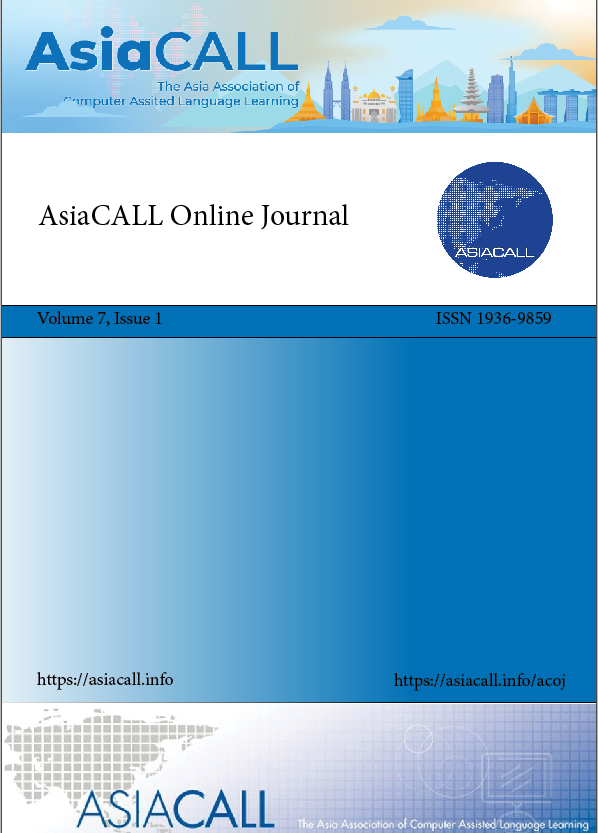L2 CMC Motivation in Task-based Computer-mediated Communications
Keywords:
computer-mediated communication competence (CMCC), CMC Motivation, L2 learning, cross-cultural, web-basedAbstract
The Internet and new technologies have enabled easy implementation of cross-cultural communications, which has also lead to new trends in L2 learning. Studies of computer-mediated communication competence are rich in content, but discussions regarding L2 language learning are rare. In recent theoretical discussions, Media factors, Message factors, Contextual factors including cultural background and Function of CMC, had correlatively influenced the Outcome of CMC interactions. However, the popularity of cross-cultural collaborative learning in English highlights the need for more attention to the possible ways to assess L2 learning via computer-mediated communication. In this study, second language CMC motivation (L2 CMC Motivation) serves as a major factor, corresponding with other factors in a cross-cultural, web-based activity oriented for English learning. This study emerged from a larger research project in which a L2 learning activity involving participants from Taiwan and Japan had exchanged ideas using a web platform communication tool established by Nicenet organization. The purpose of this paper is to understand how other factors involved in CMC interactions would correlate with L2 CMC Motivation on the side of Taiwanese students. Items adapted from Spitzberg’s (2006), were blended in a survey (Cronbach’s α=.902) to understand the correlation between the three factors to the major one L2 CMC Motivation. The results showed that the above four factors were strongly correlated. Among Message factors, expressiveness is especially related to L2 CMC Motivation. Regarding contextual factors, Patterns of behavior and Function also had significant influence on L2 CMC Motivation.
References
Castella, V. O., Abad, A. M. Z., Alonso, F. P., & Silla, J. M. P. (2000). The influence of familiarity among group members, group atmosphere, and assertiveness on uninhibited behavior through three different communication media. Computer in Human Behavior, 16(2), 141-159.
Chapelle C. A. (2009) The relationship between second language acquisition theory and computer-
assisted language learning. The Modern Language Journal 93(1), 741-753.
Kozma, R. B. (2003). Technology and classroom practices: An international study. Journal of Research
on Technology in Education 36(1). Retrieved from http://robertkozma.com/images/kozma_jrte.pdf MacIntyre, P. D. & Richard, C. (1998) Conceptualizing willingness to communicate in a L2: A situational
model of L2 confidence and affiliation. The Modern Language Journal 82(iv).
MacIntyre, P. D., Baker, S.C., Richard C., and Donovan L. (2003) Talking in order to learn: willingness to
communicate and intensive language programs. The Canadian Modern Language Review 59(4): 589-607.
MacIntyre, P.D. (2007) Willingness to communicate in the second language: understanding the decision
to speak as a volitional process. The Modern Language Journal 92(iv).
Perse, E.A. & and Ferguson, D.A. (2000). The benefits and costs of web surfing. Communication
Quarterly 48(4), 343-359.
Spitzberg, B. (2006) Toward a theory of computer-mediated communication competence. Journal of
Computer-mediated Communication 11(2). http://jcmc.indiana.edu/vol11/issue2/spitzberg.html. Spitzberg, B & Chagnon, G. (2009) Conceptualizing intercultural communication competence. In D.K.
Deardorff (Ed.), The SAGE handbook of intercultural competence (pp. 2-52). Thousand Oaks, CA:
Sage.
Whitty, M. T. (2003). Cyber-flirting: Playing at love on the Internet. Theory & Psychlogy, 13(3), 330-357. Yashima, T. (2002) Willingness to communicate in a second language: The Japanese EFL context. The
Modern Language Journal 86(i).
Yashima, T. & Shimizu, K. (2004) The influence of attitudes and affect on willingness to communicate and second language communication. Language Learning 54(1), pp. 119-152.
Downloads
Published
How to Cite
Issue
Section
License
Copyright (c) 2013 Pin-hsiang Natalie Wu, Wan-ting Chuang

This work is licensed under a Creative Commons Attribution 4.0 International License.
Copyright
The copyright of all articles published in the AsiaCALL Online Journal (acoj) remains with the Authors, i.e. Authors retain full ownership of their article. Permitted third-party reuse of the open access articles is defined by the applicable Creative Commons (CC) end-user license which is accepted by the Authors upon submission of their paper. All articles in the acoj are published under the CC BY-NC 4.0 license, meaning that end users can freely share an article (i.e. copy and redistribute the material in any medium or format) and adapt it (i.e. remix, transform and build upon the material) on the condition that proper attribution is given (i.e. appropriate credit, a link to the applicable license and an indication if any changes were made; all in such a way that does not suggest that the licensor endorses the user or the use) and the material is only used for non-commercial purposes.
Authors retain copyright and grant the journal the right of first publication with the work simultaneously licensed under a Creative Commons Attribution 4.0 International License that allows others to share the work with an acknowledgment of the work's authorship and initial publication in this journal.
Authors are able to enter into separate, additional contractual arrangements for the non-exclusive distribution of the journal's published version of the work (e.g., post it to an institutional repository, in a journal or publish it in a book), with an acknowledgment of its initial publication in this journal.
Authors are permitted and encouraged to post their work online (e.g., in institutional repositories or on their website) prior to and during the submission process.








